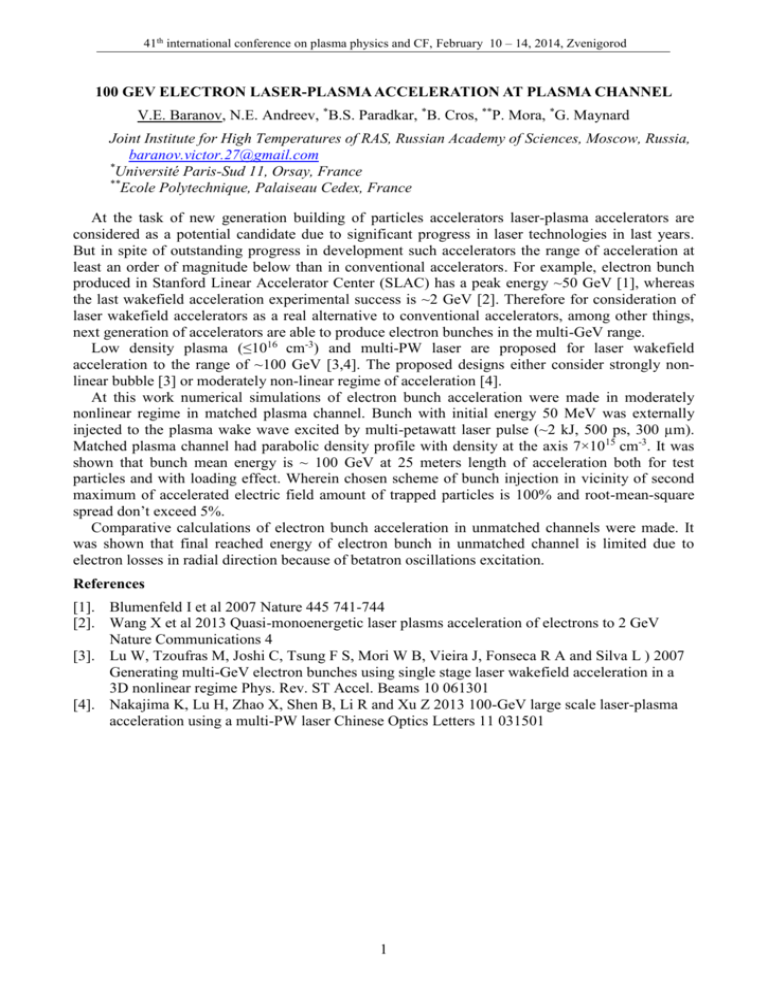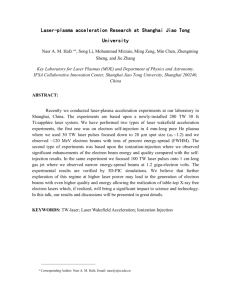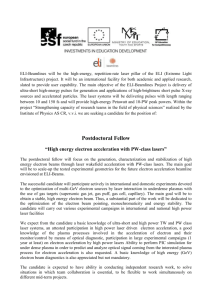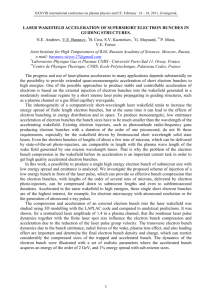100 gev electron laser-plasma acceleration at plasma channel
advertisement

41th international conference on plasma physics and CF, February 10 – 14, 2014, Zvenigorod 100 GEV ELECTRON LASER-PLASMA ACCELERATION AT PLASMA CHANNEL V.E. Baranov, N.E. Andreev, *B.S. Paradkar, *B. Cros, **P. Mora, *G. Maynard Joint Institute for High Temperatures of RAS, Russian Academy of Sciences, Moscow, Russia, baranov.victor.27@gmail.com * Université Paris-Sud 11, Orsay, France ** Ecole Polytechnique, Palaiseau Cedex, France At the task of new generation building of particles accelerators laser-plasma accelerators are considered as a potential candidate due to significant progress in laser technologies in last years. But in spite of outstanding progress in development such accelerators the range of acceleration at least an order of magnitude below than in conventional accelerators. For example, electron bunch produced in Stanford Linear Accelerator Center (SLAC) has a peak energy ~50 GeV [1], whereas the last wakefield acceleration experimental success is ~2 GeV [2]. Therefore for consideration of laser wakefield accelerators as a real alternative to conventional accelerators, among other things, next generation of accelerators are able to produce electron bunches in the multi-GeV range. Low density plasma (≤1016 cm-3) and multi-PW laser are proposed for laser wakefield acceleration to the range of ~100 GeV [3,4]. The proposed designs either consider strongly nonlinear bubble [3] or moderately non-linear regime of acceleration [4]. At this work numerical simulations of electron bunch acceleration were made in moderately nonlinear regime in matched plasma channel. Bunch with initial energy 50 MeV was externally injected to the plasma wake wave excited by multi-petawatt laser pulse (~2 kJ, 500 ps, 300 µm). Matched plasma channel had parabolic density profile with density at the axis 7×1015 cm-3. It was shown that bunch mean energy is ~ 100 GeV at 25 meters length of acceleration both for test particles and with loading effect. Wherein chosen scheme of bunch injection in vicinity of second maximum of accelerated electric field amount of trapped particles is 100% and root-mean-square spread don’t exceed 5%. Comparative calculations of electron bunch acceleration in unmatched channels were made. It was shown that final reached energy of electron bunch in unmatched channel is limited due to electron losses in radial direction because of betatron oscillations excitation. References [1]. Blumenfeld I et al 2007 Nature 445 741-744 [2]. Wang X et al 2013 Quasi-monoenergetic laser plasms acceleration of electrons to 2 GeV Nature Communications 4 [3]. Lu W, Tzoufras M, Joshi C, Tsung F S, Mori W B, Vieira J, Fonseca R A and Silva L ) 2007 Generating multi-GeV electron bunches using single stage laser wakefield acceleration in a 3D nonlinear regime Phys. Rev. ST Accel. Beams 10 061301 [4]. Nakajima K, Lu H, Zhao X, Shen B, Li R and Xu Z 2013 100-GeV large scale laser-plasma acceleration using a multi-PW laser Chinese Optics Letters 11 031501 1







